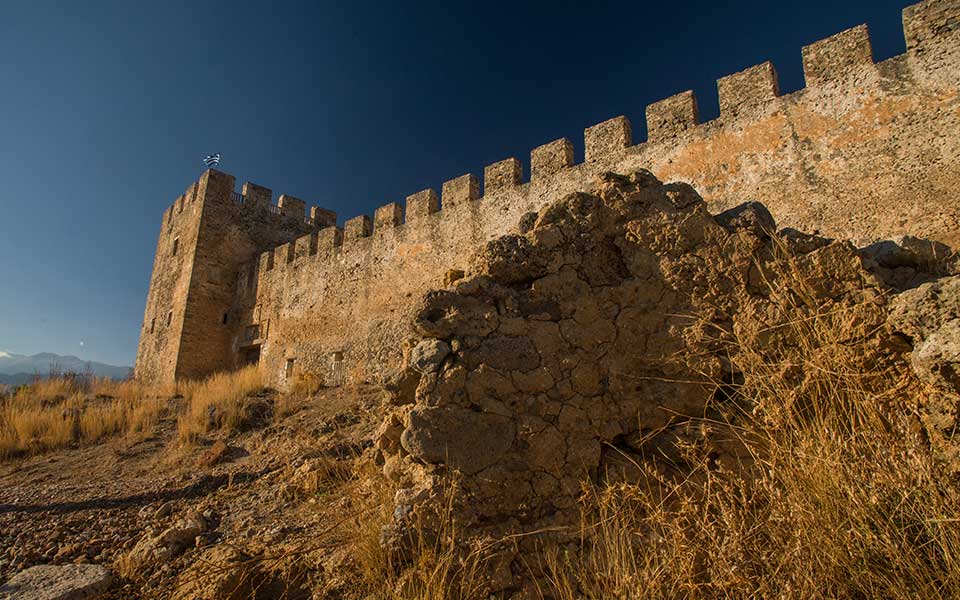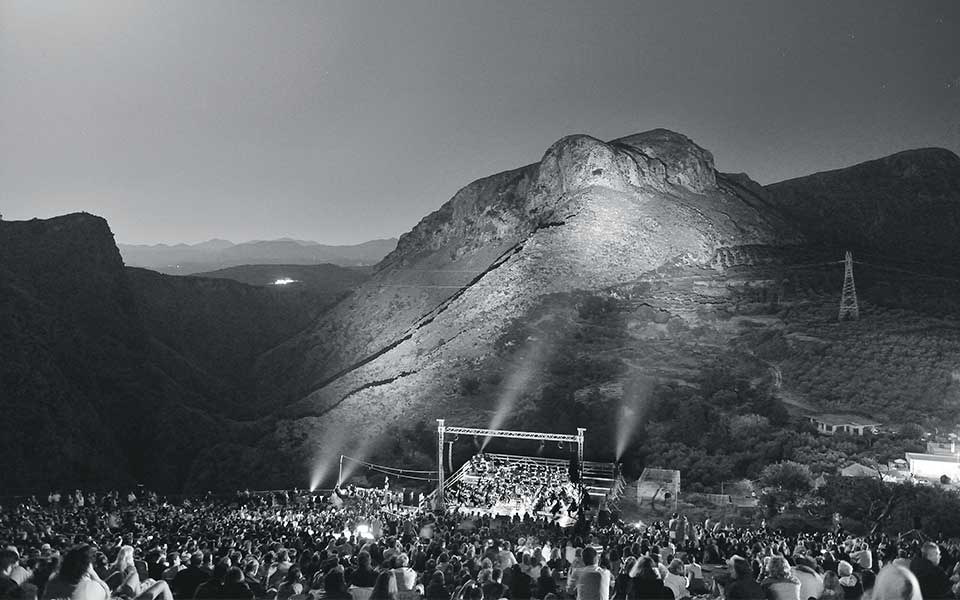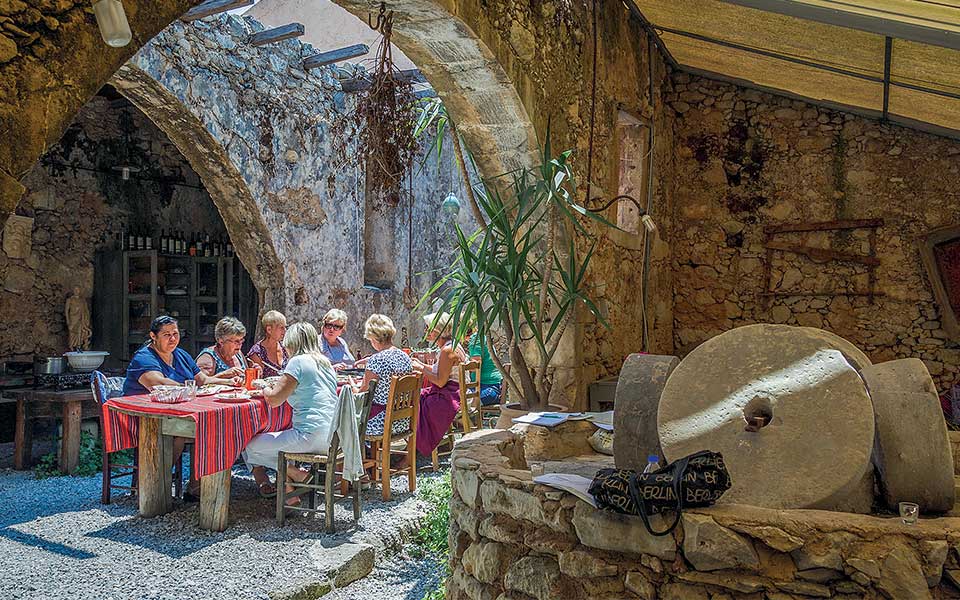From Land to Table: The Culinary Riches of...
Cretan cuisine lives on from home...

Balos Beach
© Perikles Merakos
One of the most beautiful cities in the Mediterranean, Hania (Χανιά) is a cultural amalgam worth exploring. The wider region boasts stunning beaches, such as Elafonissi, and the “king” of the Cretan canyons, Samaria.
The majestic Lefka Ori (“White Mountains”), with 50 peaks over 2000m, form a rocky barrier in the middle of the region. Nature lovers will appreciate the slopes and canyons of this mountain range, home to the Cretan mountain goat and 25 species of endemic plants which can be found nowhere else.
Temperatures vary significantly within a range of just a few kilometers. On the Askyfou Plateau in July, you’ll need a jacket, while on the remote southern beaches or on the island of Gavdos even a swimsuit is optional.
Bewitching Beaches
It’s best to start your search for the perfect photo early in the morning, before hordes of beachgoers arrive at these beaches – some of the most stunning locations in Crete – and the parking spots nearby start to fill up.
Begin with the much-vaunted beach at Balos (the shallow waters here may not suit everyone), stopping for a moment high up at the beginning of the footpath, where you can see Cape Tigani jutting out into the sea and dozens of sun worshipers dotting the white sand below. Then, head south past the expansive sea of greenhouses, until you reach the famous beach and archaeological site of Falasarna, an ancient city that flourished in the 4th and 3rd centuries BC.
Your next stop will be at Elafonisi, with its pink sand, millions of tiny shells, prickly cedar trees and shallow waters. Although this is a Natura 2000 protected area, it has so far proved impossible to regulate the massive influx of tourists and the swathes of beach umbrellas which are threatening the fragile ecosystem.
The last stop on your excursion should be Kedrodasos. Make your way through the small prickly cedar forest until you reach the beach, which is washed by crystal-clear water. Those arriving early get to enjoy the shade of the beautiful trees above the beach.
Samaria Gorge: An 18km hike through wild beauty takes you to the village of Aghia Roumeli on the shores of the Libyan Sea.
Falasarna, Elafonissi, Balos: Get ready to share your pictures; these incredible, postcard-perfect beaches are almost unbelievably beautiful.

The long and winding road that connects Anopoli with Hora Sfakion.
© Clairy Moustafellou

Marmara
© Nikos Pilos
In a nutshell
Have a wander around the four neighborhoods that make up the village of Askyfos, visit the War Museum, and drive up to the telephone tower or (if you have an off-road vehicle) all the way up to the Tavris Plateau for great views.
Spend some time in one of the quaint cafés in Kallikratis and treat yourself to some essential oils from Wild Herbs of Crete, available at the Little Café, before taking the winding road down to Frangokastello. By boat or on foot from Hora Sfakion, explore the succession of beaches along the southern coastline all the way to the stunning Domata; don’t miss Marmara and Aghios Pavlos.
In Anopoli, check out the bust of Daskalogiannis, the most popular local hero, and enjoy the view from the small church of Aghia Aikaterini. Cross the Aradena Bridge, renowned among bungee-jumpers, and take a walk around the village, once abandoned as a result of a vendetta but now slowly being repopulated. Make your way to Aloni, for a meal or a stay at the restaurant-guesthouse of Ai-Giannis. This is the last village before you enter the White Mountains.
Buy some thyme honey; eat a Sfakiani pie; and try the goat’s-milk ice cream from Giannoulis.
Check out: Leather-booted, mustachioed and dressed in black, the men of Sfakia have a reputation as fierce defenders of their land and honor.

Frangokastello
© Clairy Moustafellou
The Walking Dead
The imposing castle at Frangokastello was built by the Venetians next to an isolated beach in 1371 in order to deter pirate raids and subdue Cretan rebels in the region. When rebels occupied the castle in May 1828 during the Greek War of Independence, they were besieged by a large Turkish force under Mustafa Naili Pasha and 338 of the castle’s defenders were massacred. The castle was destroyed so that it couldn’t be used by the rebels again, but was later rebuilt.
These events remain deeply ingrained in the collective memory of the proud inhabitants of the Sfakia region; a memory that is awakened each year by a mysterious phenomenon around the anniversary of the battle, when at dawn, ghost-like shadows of the heroic defenders – called Drosoulites (lit. “Dew-men”) – appear to march towards the castle. According to scientists, this eerie spectacle is an optical illusion caused by the position of the sun at that time of year.

© Clairy Moustafellou
Stress-free, Clothes Optional
“Southern point of Europe. Smile. Relax.” This is the message that appears on the sculpture of a gigantic chair erected on the rocky headland next to Trypiti Beach by survivors of the Chernobyl nuclear disaster who chose Gavdos as their new home. The famous beaches of Aghios Ioannis and Sarakiniko are a paradise for free campers and nudists living the ultimate summer dream in the sand dunes and turquoise waters of an island that has only 100 residents (with summer numbers swelling to 3,500).
Visit the reconstructed lighthouse (the original structure, built in 1880, was destroyed during World War II) with a small museum, and then catch the breathtaking sunset. Gadvos also has a new network of walking paths.
The island is connected by ferry to Paleohora, Sougia and Hora Sfakion. The ferry schedule is rather haphazard, so it is best to contact the port authorities of Hora Sfakion (Tel. (+30) 28250.912.92) and Paleohora (Tel. (+30) 28230.412.14) in advance or visit the ferry website.
Check out: This pristine little island, Europe’s southernmost point, is a stop for migratory birds and a breeding ground for seals and sea turtles.

Dialiskari beach at Paleohora
© Clairy Moustafellou
Queen of the South
This small town with its modern – one might say unremarkable – buildings attracts visitors from all over the world, thanks to the generous amount of sunshine it receives year-round. The two long beaches that border the town, together with its restaurants, cafés and small shops, make it an ideal resort, with everything you need within walking distance. There are also two other popular beaches – Gialiskari and Krios – a bit further away from the town.
Spend at least one evening at Aghios Bar, which opened as a coffee shop in 1900, and choose from a range of delicious cocktails made with aged raki, Greek wine or brandy, and mixed with homemade jams, purées and spirits distilled from herbs and fruits.
Kolymvari: The largest olive oil-producing region on the island exports its liquid treasure to 40 countries.

© Clairy Moustafellou
Time after Time
Strategically located on a hill overlooking Souda Bay, Aptera was initially the site of the Minoan outpost of Kydonia, listed in Late Bronze Age Linear B tablets. Resettled in the 7th c. BC, it flourished through Hellenistic times as a walled citadel with far-reaching commercial and political ties, eventually declining into a minor Roman and then Byzantine town.
Aptera’s defenses reached more than 3000m in length. Today, although the site has been quarried for building material, visitors can explore traces of temples, a theater, baths, a vaulted cistern, chapels and a disused 12th-century monastery. The hilltop offers breathtaking views in all directions. Also worth seeing are the Ottoman castles of Aptera and Itzedin, just to the east. – John Leonard

© Visualhellas.gr
Faith and beauty
The 17th-century Aghia Triada Tzagarolon Monastery, still in use, is considered to be one of the most beautiful in Crete (Tel. (+30) 28210.635.72). The fortress-like Gouverneto Monastery, built in the 16th century, with impressive carved reliefs and pagan masks, stands nearby.
Park here and follow the path towards the imposing gorge to reach the cave which houses the Chapel of Panaghia Arkoudiotissa, where the goddess Artemis was once worshipped in ancient times; the cave of Erimitis, where evidence has also been found of ancient cult rituals; and the otherworldly – now abandoned – Katholikon Monastery. A few minutes after crossing the massive stone bridge spanning the gorge, you’ll reach a rocky section of shoreline where you can enjoy a refreshing swim.

Dedicated to the Full Moon
Back in 2013, a group of friends decided to bring life back to their nearly deserted village of Rokka, in the stony Kissamos mountains by holding a classical music concert. The event took place under the full August moon next to the excavated ruins of ancient Rokka with attendees sitting on the ground as if in an ancient amphitheater. The audience was mesmerized, and that first concert eventually evolved into a two-week annual event now known as Giortes Rokkas (“The Celebrations of Rokka”) that draws in crowds from near and far.
Theatrical, musical and dance performances are staged in squares, streets and private courtyards in Rokka and in the nearby village of Kera. The intimacy of these settings adds to the charm of this unique celebration.

Manousakis Winery
© Thalia Galanopoulou
Oenophile’s Paradise
The family winery of Theodoros (‘Ted’) Manousakis and his daughter, Alexandra, which is just 14km from Hania, offers a host of food and wine surprises. The facilities were built on the grounds of the Manousakis family home, in a verdant setting of trees and stepped terraces. Later, vegetable gardens were planted and a restaurant serving traditional cuisine was opened.
Begin with a tour of the winery before settling down to a wine tasting. At present, the organic vineyards produce 15 different wines. Highlights from the selection include the Nostos Romeiko, a white wine made from red grapes, and the full-bodied Nostos Mouvèrdre.
At the restaurant, you can try a variety of Cretan dishes, all simply cooked to pair perfectly with the fine wines of the Nostos series. In the shop, you’ll find excellent quality fleur de sel and extra virgin olive oil, which are both now part of the winery’s ‘Terroir’ product line.
Vatolakkos, Tel. (+30) 28210.787.87

Nektarios, Askyfou Plateau
© Clairy Moustafellou
Ntounias, Drakona
This taverna honors the concept of farm-to-table: the finest cuts of veal from a Cretan breed of mountain cattle go straight onto the charcoal grill, before being served with vegetables harvested from the garden that same morning. Tel. (+30) 28210.650.83
Kafeneio sto Scholeio, Anidri
Offers many small dishes prepared with local ingredients, as well as a few main course options, all in the shade of a very old olive tree with a view of the Libyan Sea. The venue is popular and there’s limited space, so go early. Tel. (+30) 28230.830.01
Nektarios, Askyfou Plateau
Here you’ll find the epitome of cucina povera. Pot-roasted lamb that the owner raises himself, pilaf or orzo cooked in meat broth, a house cheese, and seasonal vegetable dishes. Drink raki as an aperitif, with your meal, or as a digestif with watermelon. Tel. (+30) 28250.952.28
Chrisostomos, Marmara
The summer incarnation of the well-renowned Hania taverna Chrisostomos on this impressive beach with white rocks is situated just 15 minutes by boat from Loutro.

© Clairy Moustafellou
Where tradition lives on
The women of this picturesque village still make lace using the time-honored technique of kopaneli, in which small wooden bobbins are used to braid the threads on either a special pillow or a wooden casket. Girls here are eager to learn from their mothers and grandmothers who, unlike elsewhere in Crete, haven’t abandoned the craft.
The Historical and Folklore Museum (Tel. (+30) 28250.232.22) is worth a visit, as are the 24 Venetian wells just 1km from the village.

© Perikles Merakos
A Village Reborn
In 1994 a group of young people from Vamos in the region of Apokoronas who were living or studying far from Crete decided to return to the village to revive it. After restoring their family homes and transforming them into guesthouses, they helped establish a taverna, a café and a tourist office. Today, visitors happily dine at Sterna tou Bloumosifi, stroll through the lively village (in which a number of grand mansions still stand), and drop by the tourist office to find out about the many agritourism activities on offer, including cooking lessons, olive-picking and grape-harvesting.
Archaeologists for a day
Archaeolab is a unique archaeological dig simulation workshop, created by archaeologist Koula Borboudaki, where people of all ages – from young kids to archaeology students – can use real tools to discover and date “ancient treasures.” The innovative programs on offer include experimental archaeology seminars, where you can learn how to cook with Minoan-period utensils or make mosaics. Tel. (+30) 6939.305.668

© Clairy Moustafellou
Eco-friendly Getaway
This mountain village with its captivating 17th-century houses is nestled in a chestnut forest 53km from Hania. Electricity is generated from solar energy and is sufficient only for lighting, so put down your cell phone and go for a hike, take a cooking class, join a yoga session, or visit nearby wineries and beekeepers. In the evening, head for the atmospheric candlelit restaurant (paradoxically, the only place with electrical outlets). The restaurant is also open to the public, but be sure to make a reservation in advance. Tel. (+30) 6945.753.743, milia.gr
Cretan cuisine lives on from home...
With fewer tourists, sunlit harbors, and...
From ancient healing sanctuaries to legendary...
Just an hour from Athens, Kea...